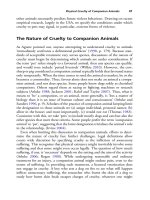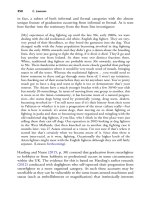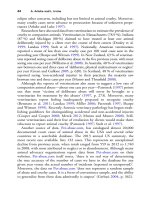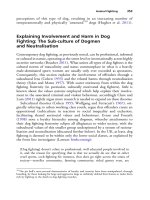The palgrave international handbook of a 194
Bạn đang xem bản rút gọn của tài liệu. Xem và tải ngay bản đầy đủ của tài liệu tại đây (26.76 KB, 1 trang )
Slaughterhouses
187
ecofeminist scholarship (for example, Griffin 1978; Ruether 1975) that
demonstrates the intersections between the oppression of women and of
nature; intersections that challenge binary and dualistic thought that
‘allows for the continued conceptualization of hierarchies in which a
theoretically privileged group or way of thinking is superior’ (Gruen in
Gaard 1993, p. 80).
Slaughterhouse Violence as Gendered
Drawing attention to the epistemologies that underpin current knowledge
systems, ecofeminists have pointed out the co-occurrence of the subjection of
women and animals. Cudworth (2011, pp. 163–169) underlines the fact that
it is female animals who are mostly used in the AIC (although this should not
be read as meaning male animals are not harmed by the AIC; bobby calves
and male chicks are routinely slaughtered shortly after birth as they are an
unwanted ‘by-product’ in an industry that relies on female reproductive
capacity):
. . . agricultural animals are gendered in two ways. First, farmed animals tend to
be female—being the most useful profit maximizers as they produce feminized
protein (eggs and dairy products) and reproduce young, as well as becoming
meat themselves. . . . Second, farmed animals are constructed in ways resembling human gender dichotomies. Breed journals, for instance, indicate that
genetics are manipulated to produce attractive, docile ‘good mothers’, and
‘virile’, strong, ‘promiscuous’ males.
Cudworth notes the circularity that pervades the AIC, pointing out that
factory farming and slaughter are ‘patriarchally closed’ systems complete with
gender segregated work and the masculinisation of work cultures (p. 166).
Focusing on the British meat industry, Cudworth explains that the AIC sits
at ‘the intersection of capitalist and patriarchal relations . . . [where] . . . the
object of domination in the manufacture of meat is patriarchally constituted’
(p. 170; see further Cudworth’s chapter in this volume).
It is worth reflecting on the notion that patriarchy not only underlies
ongoing gender relations but it sits behind the manufacture of meat. Many
will balk at these ideas, either because they refuse to consider the slaughter of
animals as violence, and/or they refute the relevance of patriarchy as an
analysis of contemporary gender relations. Well educated, progressive intellectuals might even mock protest messages such as ‘meat is murder’ or
otherwise poke fun at people concerned about the widespread, socially









